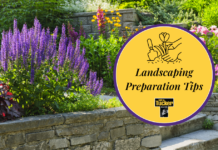Has the polar vortex wrecked your lawn? These tips for early spring lawn care will green up your lawn in no time.

A polar vortex has pounded lawns this winter with ridiculous sub-zero temperatures and record snowfalls. So don’t be surprised if parts of your lawn — especially in low-lying areas — are dead on arrival in spring.
“Snow acts like a cover, but ice is bad for turf,” says Chris Lemcke, technical director of Weed Man USA lawn care. “Ice freezes plant cells and crushes blades and leads to death.”
Freeze-thaw-freeze conditions are even worse for turf roots, which can become brittle and die. Road salt also is bad for lawns. The turf near streets and along driveways and paths may need resuscitation or replacement when spring grass should be greening up.
Dead or Sleeping?
When snow and ice melt, your late-winter turf starts awakening from hibernation and changes from brown grass to green; if your lawn died, it won’t change color.
The best way to see if your lawn is dead or sleeping is to tug the brown areas. If the turf comes up easily, the roots have failed and the grass is dead. If there’s resistance, then there’s hope.
How to Bring Lawns Back
When is the right time to bury your dead lawn — grass, roots, clinging soil — in a compost pile and start growing new grass?
- After the last chance of frost
- When night temperatures top 35 degrees
- When soil temps reach 50-65 degrees
Dead patches of lawn are easy to pull up because no roots bind the turf to the soil. Cut around dead areas with a spade, then yank up the patch.
Then it’s time to reseed.
1. Scatter seed on soil and lightly rake it in.
2. Water daily with a light mist for 15 minutes to keep soil moist. If the soil dries out, seed will not germinate.
3. When seed germinates, water deeply.
4. Feed young blades a high-phosphorous fertilizer.
5. Let grass grow at least 3 inches before its first cut.
If you can afford sod — 8-30 cents/sq. ft. compared with $28 for a 5-pound bag of seed that’ll cover 2,000 sq. ft. — Lemcke recommends laying sod on dead patches instead of seeding. Sod is more forgiving when it comes to watering and resists weeds better than seed.
Read more: http://www.houselogic.com/home-advice/lawns/lawn-care-maintenance/#ixzz3UrEWiiXi



